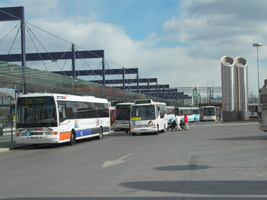 |
 |
 |
 |
 |
 |
 |
 |
 |
 |
 |
Introduction
1.1. Urban transport system
More than 75% of the population of the European Union lives in urban areas. Therefore
urban transport accounts for a significant part of total mobility, and an even
greater proportion of damage to the health of citizens and to buildings. For example,
one-fifth of all EU kilometres travelled are urban trips of under 15 km. Between
1995 and 2030, total kilometres travelled in EU urban areas are expected to increase
by 40%.

Modern transport infrastructure: Espoo bus terminal in Finland.
The car is dominant, contributing about 75% of kilometres travelled in EU conurbations.
Cars cause so much congestion that, in some European cities, average traffic
speeds at peak times are lower than in the days of the horse-drawn carriage.
Increased car use has been accompanied by safety and environmental problems,
as well as by a downward spiral of under-investment in public transport.
Urban transport contributes to global warming. More than 10% of all carbon dioxide
emissions in the EU come from road traffic in urban areas which is also the
main source of carbon monoxide and fine particulates in European cities. These
emissions pollute the immediate area and pose serious health hazards. The Kyoto
protocol calls for an 8% cut in total EU carbon dioxide by 2008–2012 with
respect to 1990 levels, but if current trends continue, CO2 from transport will
be some 40% higher in 2010 than it was in 1990.
The challenge for future urban transport systems will be to meet the demand
for accessibility for people, including people with reduced mobility, and goods,
while at the same time minimising the impacts on the environment while safeguarding
the quality of life.
A sustainable transport system is well defined by a Commission working group
on sustainable impact assessment methodology (JEGTE 2000):
”A sustainable transport system should contribute to social and economic welfare, without harming human health and the environment. Integrating the social, economic and environmental requirements, a sustainable transport system can be defined as a system that:
- allows the basic access needs and development of individuals, companies and
societies to be met safely and in a manner consistent with human and ecosystem
health, and promotes equity within and between generations;
- is affordable, operates efficiently, offers choice of transport mode,
and supports a competitive economy and regional development;
- limits emissions and waste within the planet’s ability to absorb
them, uses renewable resources at or below their rates of generation, and uses
non renewable resources at or below the rates of development of renewable substitutes
and minimises the use of land and the generation of noise.”
Feedback
A recently published “Public Perception of Urban Transport Performance and Policy” report (1) provides an overview of the public perception survey in order to provide a picture of how effective and successful the general public in urban areas of Europe perceive national policies and activities relating to urban transport to be, and where their concerns and priorities lie. In order to meet the goal of providing a snapshot of public opinion on a European basis, 200 interviews were carried out in each on the member state of the EU-15.
Based on the results of the interviews the report concludes that the key messages
from the respondents were:
- A majority consider congestion, accidents and pollution in urban areas
to be a problem.
- Majority (88%) considers fossil fuels in transport as a problem.
- Most were dissatisfied with the way their national governments are tackling
the above issues.
- Most were satisfied with public transport systems in their own city.
- Majority felt that the authorities should spend more over the next five
years on improving existing roads and on provision for walking and cycling.
- The Europe-wide split of those favouring general taxation and those
preferring targeted pricing or taxation is similar, but there are differences
between the different member states.
- Among the respondents supporting targeted pricing the majority preferred
urban road pricing rather than parking charges.
- Opinions vary according to the modes of transport modes and on the country
of resident to the interviewee, but not according to the age groups and sex.
Policies
Environmental concerns have underpinned the drive towards efficient transport
technologies including cleaner vehicles/fuels and non-technical measures to
reduce emissions. The European Union is working toward the definition and implementation
of a strategy (2) to promote sustainable mobility in an urban context which
would include a range of actions such as:
- promoting market take-up of lower-consumption vehicles and new propulsion
technologies to reduce emissions
- promoting the use of improved collective and non-motorised modes in
conjunction with mobility management schemes
- demand management schemes such as parking controls and access restrictions
- information systems for better traffic management and improving traffic
flow
- integrated intermodal freight and passenger transport systems such as
city logistics and improved terminals
- fair and efficient pricing regimes
- supporting integrated land-use and urban transport planning to minimise
the need to travel and facilitate collective transport
- promoting efficient public transport modes to people with reduced mobility
- supporting and promoting cycling
- possible contribution of teleworking
The political background of the actions is The White Paper "European transport
policy for 2010: time to decide" (3). The objective of the White Paper
was to gradually break the link between growth in transport and economic growth
through a mixed performance of transport policies, principally in three ways:
- shifting the balance of transport modes
- eliminating bottlenecks
- place users at the heart of transport policy.